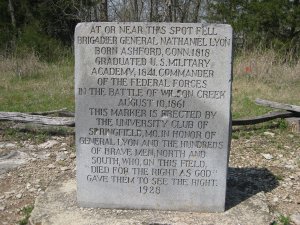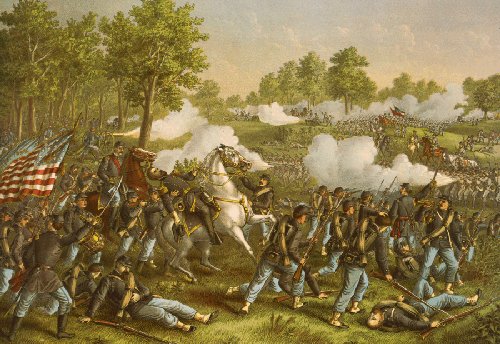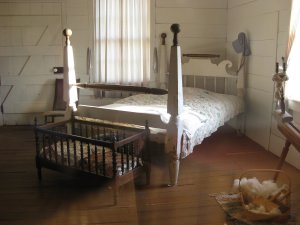Lyon's Death Marker
Tour Stop
 Location: Start from WCNB Tour Stop 7 [ Waypoint = N37 06.370 W93 24.926 ] and follow the walking trail past Totten's Battery [ Waypoint = N37 06.355 W93 24.831 ] staying to the left for about 250 yards until you reach the granite marker [ Waypoint = N37 06.301 W93 24.697 ] that marks the spot near where Union Brigadier General Nathaniel Lyon was killed in action on August 10, 1861.
Location: Start from WCNB Tour Stop 7 [ Waypoint = N37 06.370 W93 24.926 ] and follow the walking trail past Totten's Battery [ Waypoint = N37 06.355 W93 24.831 ] staying to the left for about 250 yards until you reach the granite marker [ Waypoint = N37 06.301 W93 24.697 ] that marks the spot near where Union Brigadier General Nathaniel Lyon was killed in action on August 10, 1861.
Description: Shortly after 9:00 A.M. the Missouri State Guard moved up the hill. The defending Federals opened fire. The Union artillery fired cannister that was particularly effective against the attacking enemy. It was during this second assault that Lyon was wounded as he directed the battle. It was a superficial wound to his leg. A little later during this assault, Lyon's horse was killed and then Lyon was wounded a second time, another superficial wound, but this time to his head. Lyon was dazed and moved to the rear. While here he was joined by his chief of staff, Major John Schofield. It was at this point in the battle that Lyon said to Schofield, "Major, I am afraid the day is lost." Schofield reported that he replied, "No, General, let us try it again." Major Sturgis offered Lyon his own horse and Lyon used it to return to the front. He was once again at the front directing the battle for the Federals when he was hit in the chest by a large caliber bullet. Lyon died quickly, becoming the first US General killed during the war.
 Major John Scofield, Lyon's Chief of Staff, would write about Lyon's death in his official report:
Major John Scofield, Lyon's Chief of Staff, would write about Lyon's death in his official report:
"Upon being encouraged that our troops could again be rallied, that the disorder was only temporary, he passed over to the right of the center, where our line seemed to be giving way, obtained another horse, and, swinging his hat in the air, led forward the troops, who promptly rallied around him. A few moments later he was carried from the field dead."
Scofield went to find Major Samuel Sturgis to inform him of Lyon's death so that Sturgis would assume command of the Union forces. After examining Lyon's body, Sturgis ordered the body carried to the field hospital and then evacuated to Springfield, Missouri. Lyon's body was placed in a wagon, but for some reason was removed from the wagon to be later placed in an ambulance that never arrived. The body was left unattended and forgotten as the Federals began withdrawing from the field. It was later discovered by some Arkansas soldiers who moved the body to Price's Headquarters.
 Having remained behind to help with the wounded, Union Dr. Samuel H. Melcher offered to take charge of the body. He had it removed to the Ray House where he examined the body. Melcher describes the body:
Having remained behind to help with the wounded, Union Dr. Samuel H. Melcher offered to take charge of the body. He had it removed to the Ray House where he examined the body. Melcher describes the body:
"There was a wound on the right side of the head, another in the right leg below the knee, and another, which caused his death, was by a small rifle ball, which entered about the fourth rib on the left side, passing entirely through the body, making its exit from the right side, evidently passing through both lungs and heart.... At this time he had on a dark blue, single breasted captain's coat, with the buttons used by the regular army of the United States. It was the same uniform coat I had frequently seen him wear in the arsenal at St. Louis, and was considerably worn and faded."
Melcher escorted the body to Springfield, Missouri where it was placed in Lyon's former headquarters there. Although the Federals wanted to take the general's body with them to Rolla, Missouri, there was no metal coffin available. The severity of the chest wounds made it impossible to embalm the body for travel to Rolla. Lyon was temporarily buried in the garden of the residence of John and Mary Phelps of Springfield, Missouri.
On August 22, 1861, a metal coffin arrived that had been sent by Union Major General John Fremont and a note requesting that Lyon's body be sent to Rolla, Missouri. The body eventually arrived in St. Louis, Missouri on August 26th and was sent back by steamboat and railroad to the family home in Eastford, Connecticut, and was buried in Phoenixville Cemetery on September 5, 1861.
Back: Totten's Battery
Next: The Sinkhole
